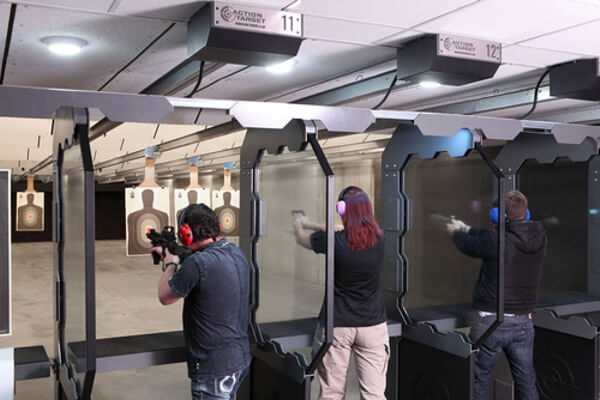Part of designing range safety behaviors means creating rules guiding firearm transportation around the facility in a proper and safe manner. To achieve this, each gun range or gun store will elaborate on the foundational rules of gun safety: assume all firearms are always loaded, keep fingers off the trigger until ready to shoot, never let the muzzle cover anything that you do not wish to destroy, and be aware of your target and the things or objects located behind the target. Most range rules will focus on how to accomplish one or more of the cornerstone rules of firearm safety. When transporting a firearm at an indoor gun range, keeping the firearm inside of a case, bag, or holster until reaching the designated shooting area satisfies several rules of gun safety. And once within the stall, the firearm is to remain there until it’s time to pack it up.
While a firearm remains in a bag, case, or holster, it is quite difficult to place a finger on the trigger – satisfying the first foundational rule of firearm safety at and indoor range. And designating the shooting stall as the only place to remove, handle, or touch a firearm satisfies the cornerstone gun rule of maintaining a safe direction at all times. However, because gun safety is something that should be practiced regardless of the environment, being mindful at the house while preparing your range bag is just as important as being mindful of safety at the range.
Family Armory range rules state:
Firearms not inside a range bag or case or holster must remain within the shooting stall.
Transporting firearms at an indoor range
Enter the store with firearms secured
Gun stores and gun ranges do not like to see people entering the front door holding a firearm. In the first place, employees and staff probably assume that their store is being robbed if they were to see this. In the second place, it is likely that those who walk through the door holding a gun would not even dream of doing the same thing at another kind of business. Would you walk through the front door of a grocery store holding a gun? Or how about a cellphone store? Or maybe a car mechanic shop? I suppose that violators believe that a gun-friendly business would be more inviting or at least more tolerant, however, both the rules of gun safety and common courtesy advise against this. Transporting a firearm safely through a gun store or range means taking the steps necessary to secure the firearm before entering the business.
Keep firearms secured while in the store
Most indoor gun ranges will designate the shooting stall as the sole place to bag and de-bag, case and un-case, and holster and un-holster a firearm. This has several implications: 1.) bags and cases are to be transported to the shooting stall – firearms are not to leave the shooting stall in order to be taken to the bag or case, 2.) removing a firearm from a bag or case on the retail floor is probably prohibited altogether or should occur under the supervision of a staff member as long as the firearm has already been made clear with the cylinder open or action locked open before entering the business, and 3.) leaving firearms unattended on the table outside the stall means that the firearm was originally removed from the bag or case outside the stall – this should never happen in the first place.
Firearms are to remain in the shooting stall
Part of the fun of shooting at an indoor gun range is making new friends taking turns shooting your neighbor’s gun. Since firearms are to remain in the shooting stall at all times, the correct procedure would be for the people to change lanes in order to shoot a different gun and not to pass firearms between lanes. Firearms are also to remain within the stall during reloading and when seeking assistance with a malfunction.
Summary: Maintaining a safe direction at all times is one of the primary rules of firearm safety. And to ensure that customers, guests, and staff maintain a safe direction at all times, indoor gun ranges develop their own rules which expand upon this primary rule. Keeping firearms inside of a bag, case, or holster during transportation helps to prevent accidental discharges.






